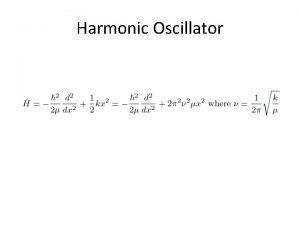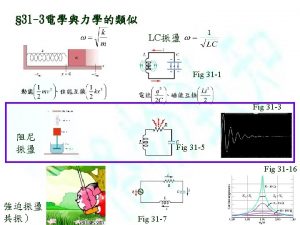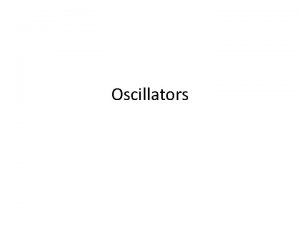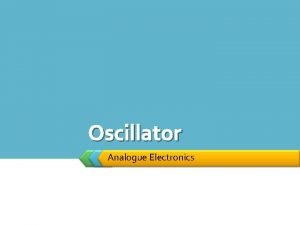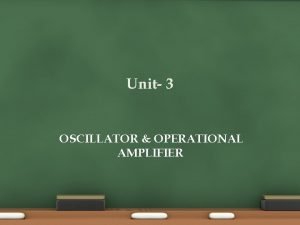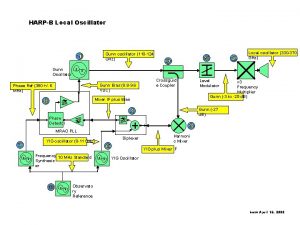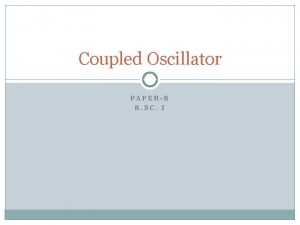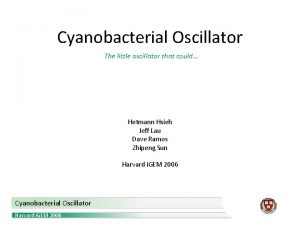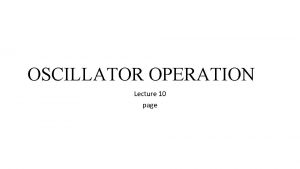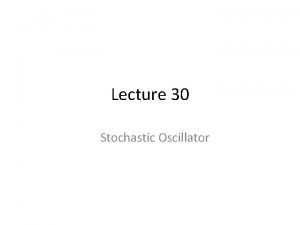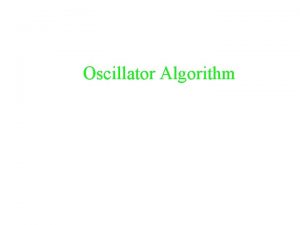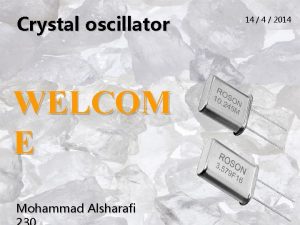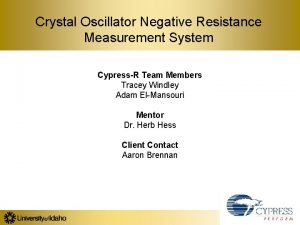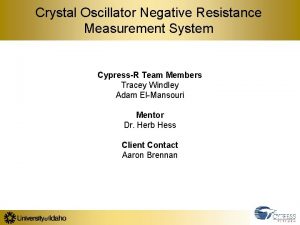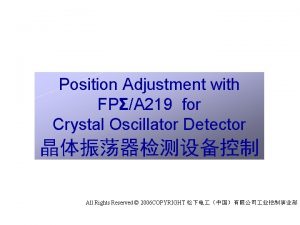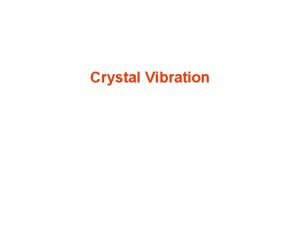Crystal Oscillator The crystal oscillator is an oscillator



































- Slides: 35

Crystal Oscillator

The crystal oscillator is an oscillator in which the � resonance circuit is a crystallization of quartz rather than coil and capacitor. It is the best type of oscillators, the lowest energy consumption and the most stable in frequency. So they are often used in radio circuits and communication equipment circuits In computer circuits and microprocessor circuits �

The most characteristic of this type of oscillators is the frequency stability. It is much better than the LC oscillator. What distinguishes these oscillators is the presence of quartz crystal (quartz crystal) With a specific pulse in its circuits.

The crystallization of the quartz used in this type of oscillators is characterized by appearance Distribute the voltage between the opposite ends when applying mechanical forces between the two parties Others, called this phenomenon (piezoelectric effect), and also when there is Constant voltage difference between two opposite sides of this crystalline shape Any mechanical changes occur to it stretch or shrink.




Colpitts oscillators:


Hartley oscillator








A phase-shift oscillator is a linear electronic oscillator circuit that produces a sine wave output. It consists of an inverting amplifier element such as a transistor or op amp with its output fed back to its input through a phase-shift network consisting of esistors and capacitors in a ladder network. The feedback network 'shifts' the phase of the amplifier output by 180 degrees at the oscillation frequency to give positive feedback.



Hartley oscillator The Hartley oscillator is an electronic oscillator circuit in which the oscillation frequency is determined by a tuned circuit consisting of capacitors and inductors, that is, an LC oscillator. The circuit was invented in 1915 by American engineer Ralph Hartley. The distinguishing feature of the Hartley oscillator is that the tuned circuit consists of a single capacitor in parallel with two inductors in series (or a single tapped inductor), and the feedback signal needed for oscillation is taken from the center connection of the two


Clopitts oscillator A Colpitts oscillator, invented in 1918 by American engineer Edwin H. Colpitts, [1] is one of a number of designs for LC oscillators, electronic oscillators that use a combination of inductors (L) and capacitors (C) to produce an oscillation at a certain frequency. The distinguishing feature of the Colpitts oscillator is that the feedback for the active device is taken from a voltage divider made of two capacitors in series across the inductor


An electronic oscillator is an electronic circuit that O produces a periodic, oscillating electronic signal, often a sine wave or a square wave. Oscillators convert direct current (DC) from a power supply to an alternating current (AC) signal. They are widely used in many electronic devices. Common examples of signals generated by oscillators include signals broadcast by radio and television transmitters, clock signals that regulate computers and quartz clocks, and the sounds produced by electronic beepers and video games

Oscillators are often characterized by the frequency of their output O signal: A low-frequency oscillator (LFO) is an electronic oscillator that O generates a frequency below approximately 20 Hz. This term is typically used in the field of audio synthesizers, to distinguish it from an audio frequency oscillator. An audio oscillator produces frequencies in O the audio range, about 16 Hz to 20 k. Hz. ] An RF oscillator produces signals in the radio O to 100 GHz frequency (RF) range of about 100 k. Hz

A crystal oscillator is an electronic O oscillator circuit that uses the mechanical resonance of a vibrating crystal of piezoelectric material to create an electrical signal with a precise frequency. [ This frequency is commonly used to keep track of time, as in quartz wristwatches, to provide a stable clock signal for digital integrated circuits, and to stabilize frequencies for radio transmitters and receivers. The most common type of piezoelectric resonator used is the quartz crystal, so oscillator circuits incorporating them became known as crystal oscillators, [1] but other piezoelectric materials

A crystal oscillator, particularly one made of quartz O crystal, works by being distorted by an electric field when voltage is applied to an electrode near or on the crystal. This property is known as electrostriction or inverse piezoelectricity. When the field is removed, the quartz - which oscillates in a precise frequency - generates an electric field as it returns to its previous shape, and this can generate a voltage. The result is that a quartz crystal behaves like an RLC circuit.

Oscillators are classified by pulse output: 1 - Sound oscillator produces frequencies in the audio range from 16 HZ to 20 HZ. 2 - the radio oscillator produces signals at the radio frequency from 100 KHZ to 100 GHZ. 3 -A low frequency oscillator is an electronic oscillator that generates frequencies below 20 HZ.

An oscillatory circuit produces electrical oscillations of a desired frequency. They are also known as tank circuits. A simple tank circuit comprises of an inductor L and a capacitor C both of which together determine the oscillatory frequency of the circuit. To understand the concept of oscillatory circuit, let us consider the following circuit. The capacitor in this circuit is already charged using a dc source. In this situation, the upper plate of the capacitor has excess of electrons whereas the lower plate has deficit of electrons. The capacitor holds some electrostatic energy and there is a voltage across the capacitor

When the switch S is closed, the capacitor discharges and the current flows through the inductor. Due to the inductive effect, the current builds up slowly towards a maximum value. Once the capacitor discharges completely, the magnetic field around the coil is maximum.


Once the capacitor is fully charged, it starts to discharge to build up a magnetic field around the coil, as shown in the following circuit diagram

1 -used in communication systems where they are used as transmitter for signal of information and at receivers as local oscillators to select channels to be received 2 -used in filter circuits that select the electrical signals to be received from thousands of signals 3 -used in medical equipment to generate electrical signals and some types of radiation 4 -also used in control systems to build small and high precision control equipment for different application such as factories and power plants

 V. c c
V. c c Gấu đi như thế nào
Gấu đi như thế nào Sự nuôi và dạy con của hươu
Sự nuôi và dạy con của hươu Thơ thất ngôn tứ tuyệt đường luật
Thơ thất ngôn tứ tuyệt đường luật Dot
Dot đại từ thay thế
đại từ thay thế Thế nào là hệ số cao nhất
Thế nào là hệ số cao nhất Thiếu nhi thế giới liên hoan
Thiếu nhi thế giới liên hoan Vẽ hình chiếu vuông góc của vật thể sau
Vẽ hình chiếu vuông góc của vật thể sau Lp html
Lp html Cách giải mật thư tọa độ
Cách giải mật thư tọa độ Vẽ hình chiếu đứng bằng cạnh của vật thể
Vẽ hình chiếu đứng bằng cạnh của vật thể Tư thế worm breton
Tư thế worm breton Hệ hô hấp
Hệ hô hấp Quá trình desamine hóa có thể tạo ra
Quá trình desamine hóa có thể tạo ra Số nguyên là gì
Số nguyên là gì Các châu lục và đại dương trên thế giới
Các châu lục và đại dương trên thế giới điện thế nghỉ
điện thế nghỉ Bổ thể
Bổ thể ưu thế lai là gì
ưu thế lai là gì Thế nào là sự mỏi cơ
Thế nào là sự mỏi cơ Phép trừ bù
Phép trừ bù Từ ngữ thể hiện lòng nhân hậu
Từ ngữ thể hiện lòng nhân hậu Vẽ hình chiếu vuông góc của vật thể sau
Vẽ hình chiếu vuông góc của vật thể sau Chúa yêu trần thế alleluia
Chúa yêu trần thế alleluia Tư thế ngồi viết
Tư thế ngồi viết Một số thể thơ truyền thống
Một số thể thơ truyền thống Công thức tiính động năng
Công thức tiính động năng Tư thế ngồi viết
Tư thế ngồi viết Tỉ lệ cơ thể trẻ em
Tỉ lệ cơ thể trẻ em Hổ đẻ mỗi lứa mấy con
Hổ đẻ mỗi lứa mấy con đặc điểm cơ thể của người tối cổ
đặc điểm cơ thể của người tối cổ Diễn thế sinh thái là
Diễn thế sinh thái là Các châu lục và đại dương trên thế giới
Các châu lục và đại dương trên thế giới Phản ứng thế ankan
Phản ứng thế ankan Thế nào là mạng điện lắp đặt kiểu nổi
Thế nào là mạng điện lắp đặt kiểu nổi







































